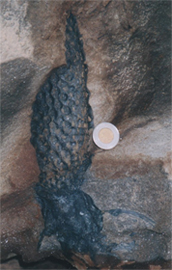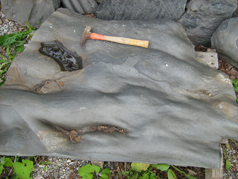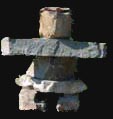Geology
 Near Pynn's Brook, bluestone is quarried from Lower Carboniferous rocks.
These were formed 350 million years ago in a delta, similar to where the Humber River flows into Deer Lake in Western Newfoundland.
Near Pynn's Brook, bluestone is quarried from Lower Carboniferous rocks.
These were formed 350 million years ago in a delta, similar to where the Humber River flows into Deer Lake in Western Newfoundland.Pennsylvania bluestone was used extensively in the 19th century for paving, sidewalks, kerbs, cobblestones, walls, and buildings in the cities of northeastern USA. In the past 20 years a resurgence of use has occurred with the major market being patio stone, benches, steps, walls and paths in landscaping.
Comparable flagstone is quarried in the US and at the Cliffs of Moher, west Ireland, and in Yorkshire, England (Millstone Grit).
Since the deposit is a fossil beach, any texture you find on a sandy beach is found in our stone. Many specimens are of museum quality. Most natural stone surfaces have an attractive riven texture with mild irregularities.
 Geological features include:
Geological features include:
- ripple marks
- mud cracks
- rain pits
- fossil vegetation
- load cast and slump structures
- volcanic ash
- sedimentary layering
- curved slabs (channels for waterfalls)
- bowl shaped slabs (for birdbaths)
- Zen quality blocks and slabs
- slabs with drill holes (useful for fountains)




